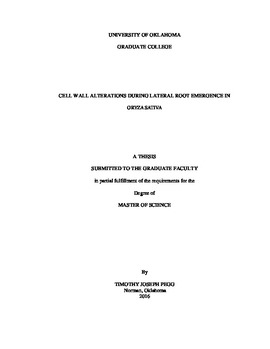| dc.contributor.advisor | Bartley, Laura | |
| dc.contributor.author | Pegg, Timothy | |
| dc.date.accessioned | 2016-05-18T15:14:30Z | |
| dc.date.available | 2016-05-18T15:14:30Z | |
| dc.date.issued | 2016 | |
| dc.identifier.uri | https://hdl.handle.net/11244/34743 | |
| dc.description.abstract | In rice seedlings, lateral roots (LRs) develop through several layers of extant tissues, including multiple cortex cell layers, as well as single files of sclerenchyma, exodermis, and epidermal cells. In contrast to typical development in which plant cells maintain a static shape when growth ceases, the shape of cells overlying emerging LRs alters to accommodate LR growth away from the stele. Understanding changes in cell wall components in cells overlaying lateral root primordia (LRP) during lateral root emergence (LRE) may lead to optimization of root cell architecture, improved nutrient and water uptake, and understanding of how plants control degradation of their own cell walls. This study identifies cell wall compositional changes in cells overlying the LR primordium using light microscopy. Examination of cross-sections revealed decreasing autofluorescence signal in sclerenchyma tissues overlaying emerging LR primordia, implying reduction of abundance of fluorescent phenolic compounds in these cells’ wall matrix. In contrast, immunofluorescence with antibodies targeting specific cell wall components such as p-coumaric acid and p-coumarate esters in lignin (INRA-COU1) and xyloglucan (CCRC-M100), detected increased fluorescence signal in exodermis and sclerenchyma layers overlaying emerging LRPs. Enhanced antibody binding signals of pectin epitopes for de-methyl esterified homogalacturonan (LM19), partially methyl-esterified homogalacturonan (JIM5) and fully methyl-esterified homogalacturonan (LM20) was also observed in exodermis and sclerenchyma tissues overlaying LRPs. These pectin epitopes are known to play a role in the formation of calcium-mediated cross-linking of pectin structures which increase primary cell wall strength but also vulnerability to degradation by polygalacturonases. This data suggests that cell wall matrix alterations may influence cell wall integrity and cellular adhesion to allow proper extension of developing LRP through multiple rice root tissue layers. Additional research established a method of harvesting rice cell files in cross-sections overlying emerging LR through laser-capture microdissection and RNA extraction. Extracted RNA will be utilized to perform future transcriptome analysis through RNA-seq to determine patterns of up- and down-regulated gene expression that may reveal the transcripts that control cell wall degradation and cellular deformation during LR emergence past cells with primary and secondary walls for future genetic manipulation of the process. | en_US |
| dc.language | en_US | en_US |
| dc.subject | rice, plant, cell wall, lateral root, lateral root initiation, remodeling, enzyme, LRP, LRI, CWR, pectin, xyloglucan, LM19, CCRC-M100, INRA-COU1, CCRC-M130, CCRC-M14, | en_US |
| dc.title | Cell Wall Alterations During Lateral Root Emergence in Oryza Sativa | en_US |
| dc.contributor.committeeMember | Kessler, Sharon | |
| dc.contributor.committeeMember | McCauley, David | |
| dc.date.manuscript | 2016-05-13 | |
| dc.thesis.degree | Master of Science | en_US |
| ou.group | College of Arts and Sciences::Department of Microbiology and Plant Biology | en_US |
